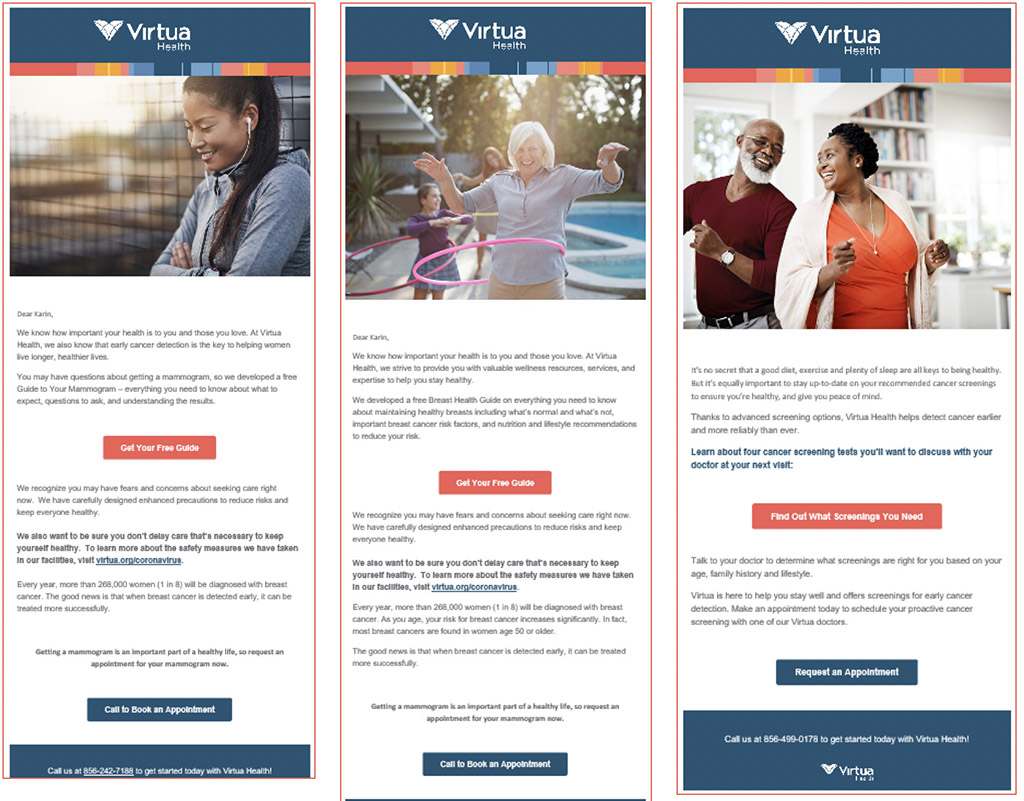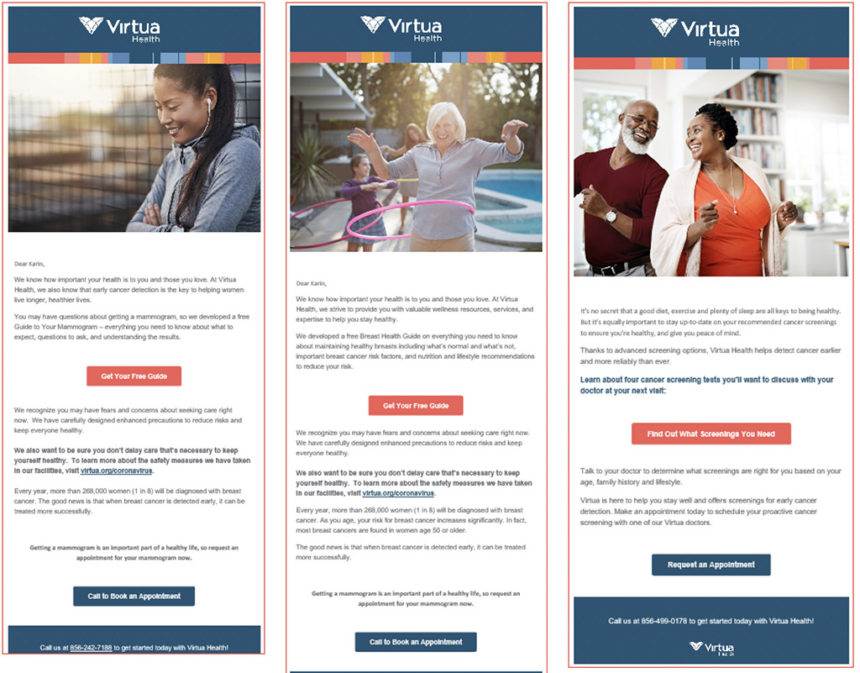Marketers were already helping hospitals and health systems build revenue and loyalty, not just brand awareness, before the pandemic. COVID-19 accelerated the shift, as regional health systems were forced to think beyond mass-media radio and roadside ads to more targeted, data-driven methods of bringing patients back to see their doctors.
In the case of Virtua Health, a $2 billion, not-for-profit health system located just over the bridge from Philadelphia, that meant an AI-driven campaign last fall reminding high-risk patients of necessary screenings and other elective procedures they may have missed. Its effort ended up influencing some 11,000 mammogram appointments, resulting in hundreds of breast cancer diagnoses that may have otherwise gone undetected.
Virtua VP of marketing Ryan Younger led what he dubbed the “reactivation” campaign. “We had been telling people to stay away from hospitals – and stay away from everybody, with all of the social distancing,” he recalled. “Executive leadership had said, ‘We need to make sure people know we didn’t mean medical distancing. They need to get the right screenings. How can you help?’”
In response, Younger’s marketing team leaned on research it had been conducting to better understand Virtua’s patients – in particular, which ones were at higher risk for different diseases and the types of screenings that could help them. In conjunction with the clinical team, Younger and his marketing cohorts settled on an educational campaign letting people know it was safe to reenter the health system and about the types of care they should consider.
“We started with breast cancer, because it was an area where we had seen volume fall off. We knew screenings had been avoided,” Younger said.
Prioritize higher-risk patients
Medical guidelines recommend annual mammograms for women aged 45 to 54, but it was critical to prioritize those individuals at higher risk. For instance, overweight and obese women have a higher risk of being diagnosed with breast cancer compared to women who maintain a healthy weight, especially after menopause. The same holds for current or past users of hormonal therapies.
Younger’s team worked with an external CRM intelligence vendor, Actium Health, to transform deidentified patient data into a plan of action. With the help of AI modeling and guided by a Virtua breast cancer surgeon, the team considered third-party payer datasets in addition to a patient’s age and family history. Emails segmented different demographics and calls to action based on where someone might be in their healthcare journey.
The AI stratified patient groups by decile of risk, showing whom to reach out to, but at no point in the process were marketers privy to those names.
“When the email goes out, it’s going to an identified target group, but no one is looking at that info,” Younger stressed, adding that his group worked with the health system’s privacy team on language to prevent patients from feeling creeped out. “You want to communicate to the right people that it’s going to help, but obviously people don’t want their health information exposed. That’s the balance.”
The four-month campaign started in August 2020, a time when people were still not back at work or having family gatherings. That meant health systems like Virtua were swimming against the current.
“It was a time when we as a society were trying to move between phases,” Younger recalled. “Most people, all they heard was, ‘Stay away, stay away.’ We had to think through a strategy of, ‘How were we going to let them know it was OK, that it was time to come back and that safety protocols were in place?’”

Younger’s team found a helpful talking point in the new-look healthcare system. Mobile check-ins had displaced the brick-and-mortar waiting room, while telehealth had chipped away at in-person visits.
“There was a whole new dynamic to it,” Younger said. “We reminded them that we had been in this the whole time. We could talk to them about all the safety measures that were in place.”
Back in spring 2020, email blasts had gone into extensive detail about new expectations and cleaning protocols. The breast cancer campaign used a more general safety message – “We recognize you may have fears and concerns about seeking care right now…” – designed to reinforce the earlier emails while driving people to Virtua’s website for the most relevant information.
Almost 1,400 diagnoses
Virtua says its targeted campaign influenced more than 11,000 mammogram appointments, which resulted in 1,395 breast cancer diagnoses for patients that may not have otherwise scheduled their screening. Younger credited the performance to the partnership between Virtua’s marketing and clinical teams.
“If we can educate people more and help get the message out, they’re going to access more services and let the clinical folks do their job,” he said. “I think people would have stayed away from care longer if we hadn’t taken this approach.” Virtua has since replicated the approach in the cardiovascular, orthopedics and spinal spaces.
Meanwhile, the organization reports that the campaign resulted in nearly 10,000 life years gained for its patient population as a result of therapeutic intervention. Younger says this metric demonstrates the value of early detection.
“If you don’t do this type of care and you find disease a lot later, it can be really problematic. You might have fewer options,” he explained.
However, Younger stressed that, while people who haven’t been to a doctor’s office in a while often benefit from proactive communication, marketers should neither exaggerate the urgency nor veer from their swim lanes. The point of this kind of marketing, he said, should always be to “activate people to talk to their doctor, to get them in the hands of their clinician and let them do what they do best.”
Targeted engagement represents newly formed tissue for health systems. In the past, marketers would market their system and its services to new and existing patients, while the clinical team would provide service. Now, these groups are collaborating more in touting the advantage of early care. And rather than solely blasting a message through a billboard, they’re focusing on the people for whom the message is most relevant.
Other industries do this well. Think of your car dealer’s ubiquitous advertising that, “It’s time for your 3,000-mile oil change, or the vet reminding you to bring in your pet for a seasonal check-up.
“Healthcare, in some ways, has not done as much of that as other industries,” said Younger. “That’s what we’re trying to get better at, because there’s a real opportunity there to help people know their risk and know what to do and stay proactive.”
Mass-media tactics still have their place, however. Virtua uses radio and TV spots to maintain awareness in its broader three-county market as part of its post-COVID ad campaign.
“We have to keep a steady message because we’re competing with a lot of Philly institutions who have a lot of brand recognition,” Younger said.
Marketers of healthcare services are getting better at using a mix of channels.
“Organizations must adopt a mindset of thinking about healthcare consumers in new ways,” said Younger. “We can be that trusted source of information. We won’t push services they don’t need, and we have no agenda. We’re a not-for-profit whose motto is, ‘Be well. Stay well. Get well.’ That’s what we’re encouraging people to do, not wait for that acute-care episode.”







